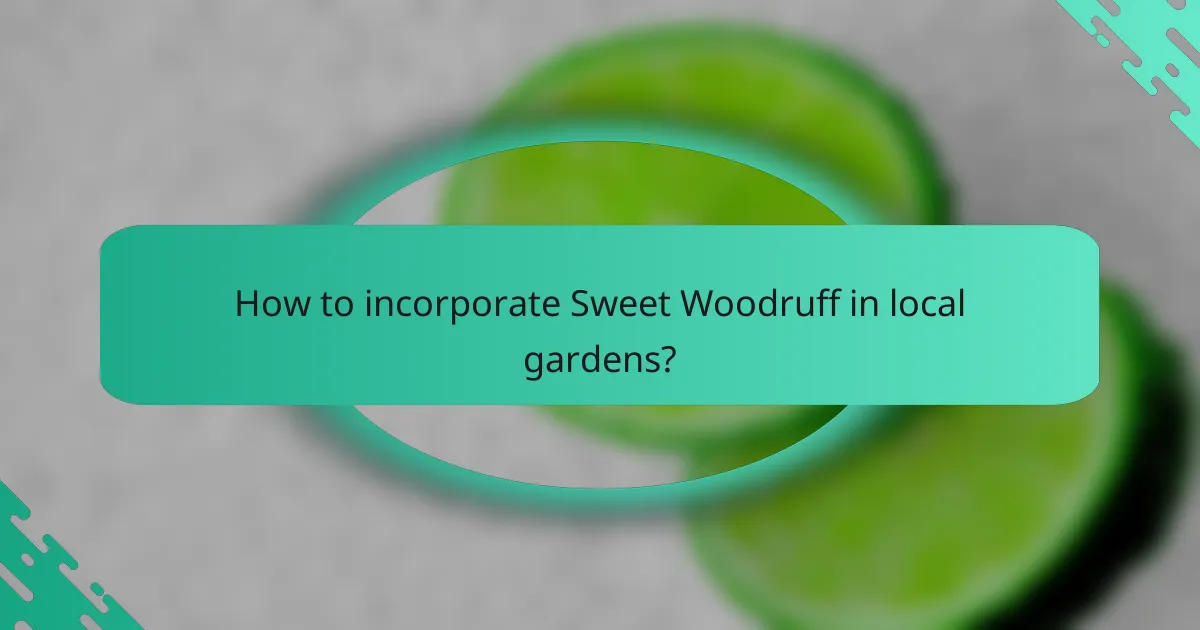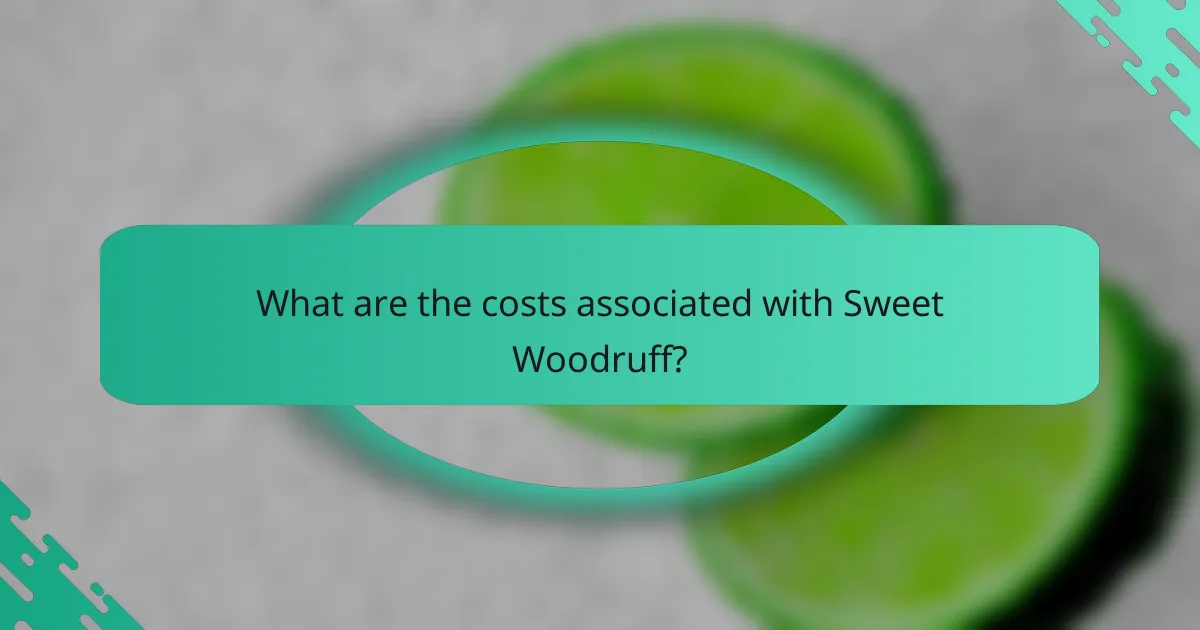Sweet Woodruff is a fantastic ground cover option for shaded gardens, known for its lush green foliage and delicate white flowers. Its low-maintenance nature makes it an ideal choice for gardeners looking to enhance their landscapes with minimal effort, while its versatility allows for creative design in woodland gardens, containers, and mixed plantings.

How to incorporate Sweet Woodruff in local gardens?
Sweet Woodruff is an excellent choice for enhancing local gardens, particularly in shaded areas. Its low-growing nature and fragrant foliage make it a versatile plant for various landscaping designs.
Ground cover for shaded areas
Sweet Woodruff thrives in shaded environments, making it an ideal ground cover for areas that receive limited sunlight. It can effectively suppress weeds while providing a lush green carpet that enhances the aesthetic appeal of your garden.
When planting, consider spacing the plants about 12 to 18 inches apart to allow for adequate growth. This spacing helps create a dense cover over time, ensuring that the soil remains moist and cool.
Companion planting with hostas
Pairing Sweet Woodruff with hostas can create a visually appealing and functional garden space. The contrasting textures and colors of hostas complement the delicate foliage of Sweet Woodruff, enhancing the overall design.
Both plants enjoy similar growing conditions, such as moist, well-drained soil and partial to full shade. This compatibility makes them excellent companions, as they can thrive together without competing for resources.
Edible landscaping options
Sweet Woodruff is not only ornamental but also has culinary uses, making it a great addition to edible landscaping. Its leaves can be used to flavor beverages, desserts, and even salads, providing a unique taste profile.
When incorporating Sweet Woodruff into an edible garden, ensure it is planted in areas where it can thrive without overshadowing other edible plants. This allows for a diverse garden that is both beautiful and functional.

What are the design ideas for Sweet Woodruff?
Sweet Woodruff is a versatile ground cover that thrives in shaded areas, making it ideal for various garden designs. Its delicate white flowers and lush green foliage can enhance the aesthetic of woodland gardens, container arrangements, and mixed plantings.
Mixing with ferns and shade plants
Sweet Woodruff pairs beautifully with ferns and other shade-loving plants, creating a lush, layered effect in your garden. Consider combining it with plants like hostas, astilbes, or Japanese painted ferns to add texture and visual interest.
When mixing, ensure that the moisture and light requirements of all plants align. Sweet Woodruff prefers moist, well-drained soil and partial to full shade, making it an excellent companion for other shade dwellers.
Creating a woodland garden
Incorporating Sweet Woodruff into a woodland garden can create a serene and naturalistic environment. Use it as a ground cover beneath trees and shrubs to help suppress weeds while providing a soft carpet of greenery.
To design a woodland garden, layer plants of varying heights, placing taller species like dogwoods or redbuds at the back and lower plants like Sweet Woodruff in front. This arrangement not only enhances visibility but also promotes biodiversity.
Using in container gardens
Sweet Woodruff can thrive in container gardens, adding a touch of elegance to patios or balconies. Choose a container that allows for good drainage and fill it with a rich potting mix that retains moisture.
When using Sweet Woodruff in containers, consider pairing it with other shade-tolerant plants like begonias or impatiens. This combination can create a vibrant display while ensuring that all plants thrive in similar conditions.

What are the maintenance requirements for Sweet Woodruff?
Sweet Woodruff requires minimal maintenance, making it an ideal choice for gardeners seeking low-effort ground cover. Regular watering, occasional pruning, and pest management are the primary tasks to ensure healthy growth.
Watering needs
Sweet Woodruff thrives in consistently moist soil but is tolerant of short dry spells. Watering should be done deeply but infrequently, aiming for about once a week during dry periods. Ensure the soil remains damp but not waterlogged to prevent root rot.
Pruning and dividing
Pruning Sweet Woodruff helps maintain its shape and encourages new growth. Trim back any dead or overgrown stems in early spring before new growth appears. Dividing the plants every few years can also rejuvenate them and prevent overcrowding, typically in early spring or fall.
Pest management strategies
Sweet Woodruff is generally resistant to pests, but occasional issues with slugs or aphids may arise. To manage these pests, consider using organic methods such as handpicking or introducing beneficial insects like ladybugs. Regularly inspect plants for signs of infestation and treat promptly to maintain plant health.

What are the costs associated with Sweet Woodruff?
The costs associated with Sweet Woodruff include the purchase price per plant, installation expenses for landscaping, and long-term maintenance costs. Understanding these factors can help you budget effectively for incorporating this versatile ground cover into your garden.
Purchase price per plant
The purchase price for Sweet Woodruff typically ranges from a few dollars to around ten dollars per plant, depending on the size and source. Local nurseries may charge more than online retailers, so it’s worth comparing prices. Buying in bulk can also lead to discounts, especially for larger landscaping projects.
Installation costs for landscaping
Installation costs for Sweet Woodruff can vary significantly based on the complexity of your landscaping project. If you hire a professional landscaper, expect to pay anywhere from $50 to $100 per hour for labor, plus materials. For DIY enthusiasts, the main costs will involve soil preparation and any necessary amendments, which can be relatively low.
Long-term maintenance expenses
Long-term maintenance expenses for Sweet Woodruff are generally minimal, as this plant is known for its low upkeep. Regular watering and occasional weeding are usually sufficient to keep it healthy. However, you might spend a small amount annually on mulch or organic fertilizers to promote growth, typically around $20 to $50 per year.

What are the benefits of using Sweet Woodruff in landscaping?
Sweet Woodruff offers numerous benefits in landscaping, including its low maintenance requirements, aesthetic appeal as a ground cover, and ability to deter pests naturally. These qualities make it an excellent choice for both novice and experienced gardeners looking to enhance their outdoor spaces.
Low maintenance plant
Sweet Woodruff is a hardy perennial that thrives in a variety of conditions, requiring minimal care once established. It grows well in shaded areas and tolerates poor soil, making it ideal for low-maintenance gardens. Regular watering during dry spells is beneficial, but overall, it does not demand frequent attention.
To keep Sweet Woodruff healthy, occasional trimming may be necessary to control its spread. This plant typically does not require fertilization, which further reduces upkeep costs and labor.
Attractive ground cover
As an attractive ground cover, Sweet Woodruff features lush green foliage and delicate white flowers, creating a visually pleasing carpet in shaded areas. It can effectively suppress weeds, allowing for a tidy garden appearance without the need for herbicides.
When planted in clusters, Sweet Woodruff can enhance the aesthetic of pathways, borders, and under trees. Its ability to spread quickly means it can cover large areas, providing an effective solution for erosion control on slopes.
Natural pest deterrent
Sweet Woodruff acts as a natural pest deterrent, helping to repel common garden pests such as aphids and mosquitoes. Its aromatic leaves contain compounds that are unappealing to these insects, making it a beneficial addition to vegetable and flower gardens.
Incorporating Sweet Woodruff alongside other plants can create a more balanced ecosystem, reducing the need for chemical pesticides. This not only promotes a healthier garden but also supports local wildlife, such as beneficial insects and pollinators.


